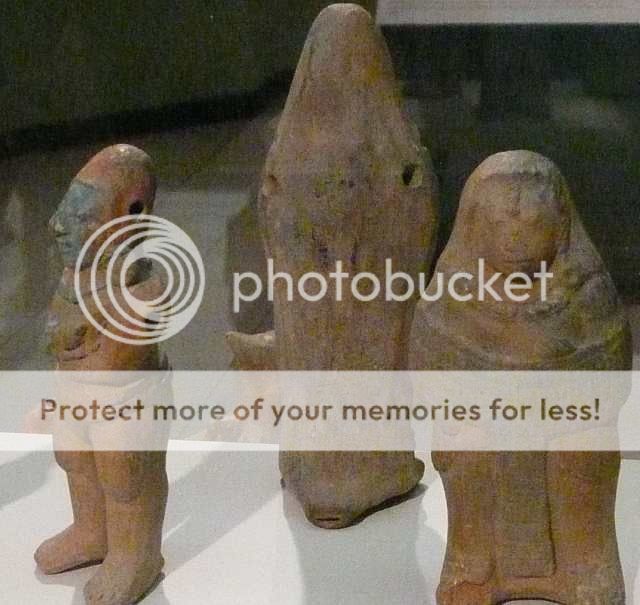PLAIN HEAD
We spent several rewarding hours at the twin museums on the campus of Francisco Marroquin University, Zona 10, a half hour walk from our hotel in Guatemala City.
The Ixmel is full of textiles, looms, weavings, old photos, etc, curated in a modern style which I liked a lot. Also, some lovely ‘primitive’ paintings from an early 20th century Guatemalan artist whose grandchild could be drawing many of the same scenes today. And, some sophisticated watercolor portraits done by a British woman who I think had a coffee plantation in the hills.

After this, no photos were allowed in the textile museum- fragile colors. Lo siento.
In the Ixmel, you’ll start to realize just what you’re seeing when you look at Mayan women on the street. What I see is an astonishing number of women all wearing the same thing, a voluminously pleated modest skirt plus a blouse, and an overblouse of a lacy material, which strikes me as modesty made practical in a tropical climate. Inland I also saw huipil, which is a different kind of blouse with much embroidery (once done by hand, now more machine embroidered) around the neckline.
Considering the heat, and the need to breast-feed, and the lack of sanitary facilities, I guess it’s a reasonable rig, even though it looks like more cloth than necessary, and hot.
What I hadn’t fully appreciated before Ixmel was the individuality of the fabrics and the embroidery. Each locale has something special, and for someone who can read the signs (which might be every Guatemalan) there’s a wealth of information being conveyed. Also, I hadn’t considered the apron as a fashion accessory, but you’ll regularly see tucked and ruffled aprons on the streets of the city.
There are plenty of women in traditional dress, but others, including men, and youth, wear the 21st century uniform. A side note about clothing: one of the places you can buy clothes is at a ropa americana. Sometimes there’s a storefront, but often you’ll see being sold in the back of a truck, on a tarp on the ground, or maybe even on hangers, what looks like the overflow, like what goes to Goodwill, Salvation Army and Frenchy’s. Not being a size 1 chica, it’s where I’d shop if I needed something, which thankfully I don’t.
Here, if you care to dig, you’ll find larger-than-Mayan sizes and sometimes better quality- at least it was originally. I see lots of people, especially men, wearing ‘ropa americana’ t-shirts, without a care about the logo. Howard’s Plumbing, Palm Beach Polo Club, it seems that Guatemala is downstream from every t-shirt ever printed. Sometimes it works: a cute little girl in a pink shirt with sequins reading “Precious”. And sometimes it doesn’t: a skinny older man whose t-shirt read: “Nobody Knows I’m Really a Lesbian”.
Popul Voh Museum is artifacts from various ruins throughout the country. You can pay 15Q extra and take pictures. Doug frowned (“there’s nothing worse than a tourist with a camera” is his view), but I paid, happily (the camera has a better memory than I do) and here’s a little of what I saw.
The Popul Vuh Museum is named after a book, one of the few to survive, which describes the Mayan myth of creation. The collection was once private and is noted for its pre-Columbian (that’s Before Christopher Columbus to me!) funerary art and its bowls and vessels.
Pictured below is a photo of a reproduction of part of another of the very few surviving Mayan manuscripts, the Dresden Codex. This is an example of the source material upon which our current knowledge is based.

“The Dresden Codex contains astronomical tables of outstanding accuracy. It is most famous for its Lunar Series and Venus table…The Dresden Codex contains predictions for agriculturally-favorable timing[citation needed]. It has information on rainy seasons, floods, illness and medicine. It also seems to show conjunctions of constellations, planets and the Moon.”
Wikipedia
I liked all the funerary ‘urns’, though they did seem rather small.

But what really struck me was the small sculptures and the busts, perhaps because they were so personably captioned. It was like looking at a centuries-old photo album. At last I felt like I was peeking into Mayan daily life.
For instance, here are little heads displaying the variety of hairstyles available, indicating, according to the caption, an interest in fashion. I can relate!

Effigies emphasized feminine charm and sensuality and point out that young goddesses played important mythological roles. The one on the left particularly, I can see in that kind of function. She might be 14, on the streets of Fronteras, or Birmingham, Alabama.

The youths, male variety, of the nobility, were strenuously educated in the arts and writing, cults of the gods and military arts. These guys look like they’re just hanging out on the corner though, as surely those youths also did.

Here’s a warrior (not a Warrior), wearing cotton armor, carrying square shield and mace. They often wear masks and helmets decorated with animals, said the sign. In fact, in some cases, the warrior’s victims were flayed, which is to say skinned, and their ‘features’ worn as a mask. What a reminder!
WARRIOR
Musicians, players of the drums, turtle carapaces, rattles and trumpets, were an important part of many ceremonies, including sacrifices. This is a pretty terrible picture, admittedly, but you can see the guy on the right is the drummer in this band. The odd colors are interesting to me, but not desirable photographically, since they apparently indicate ‘noise’.

The abuelas, “aged women”(!), were important in domestic and religious life too, as midwives, and in myth, where the heroes were often orphans raised by their grandmother. I guess their warrior fathers didn’t make it home.

Large noses and crossed eyes were considered attractive.
Mainly what I learned at the museum is that, when (okay, if) our culture, like that of the Mayans, mysteriously disappears as a result of environmental degradation and greedy heedless behavior, our successors might have a museum much like this one, same captions, but slightly different illustrations. Let’s see, Vogue magazine, Forest Lawn, silicon breast implants, …
Hope you enjoyed the tour!

for more pictures look at
www.maya-archaeology.org/museums/popolvuh/popolvuhpictures.php –
Edited 18 Sept.


















